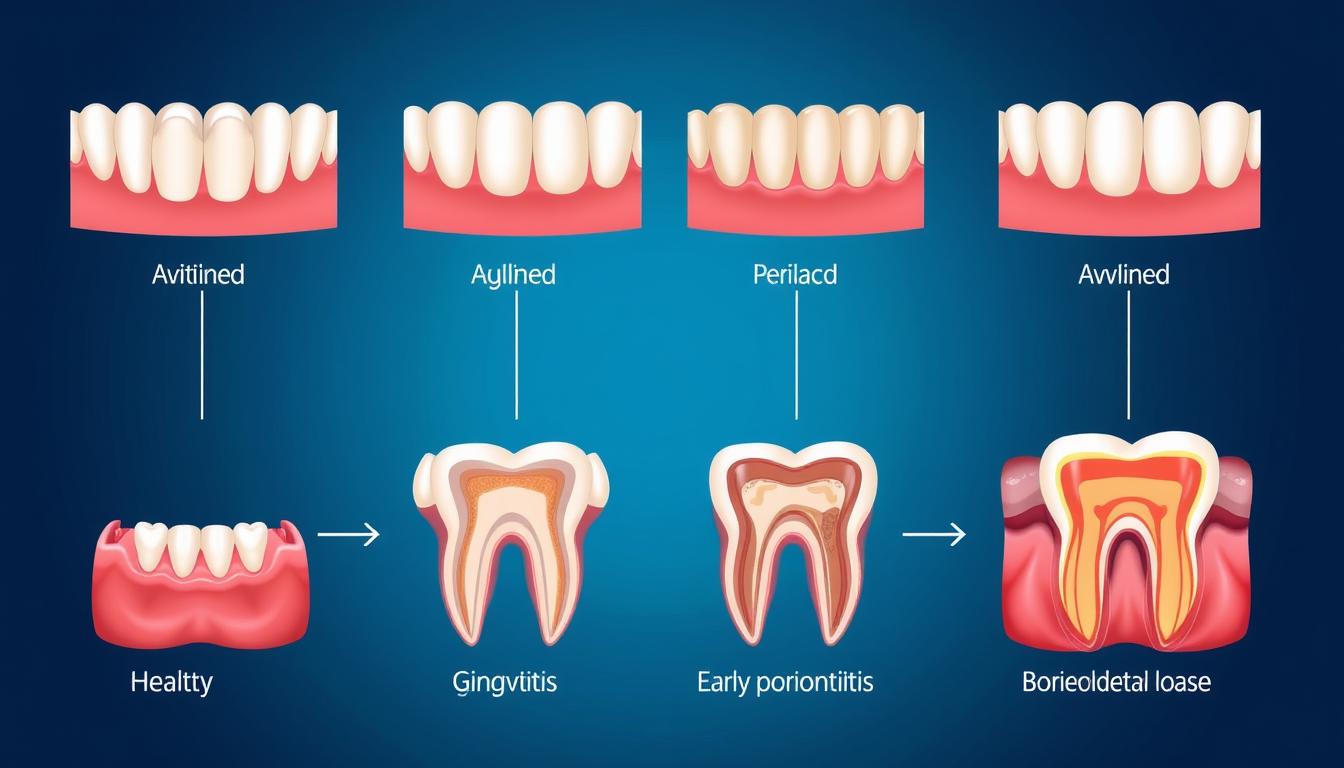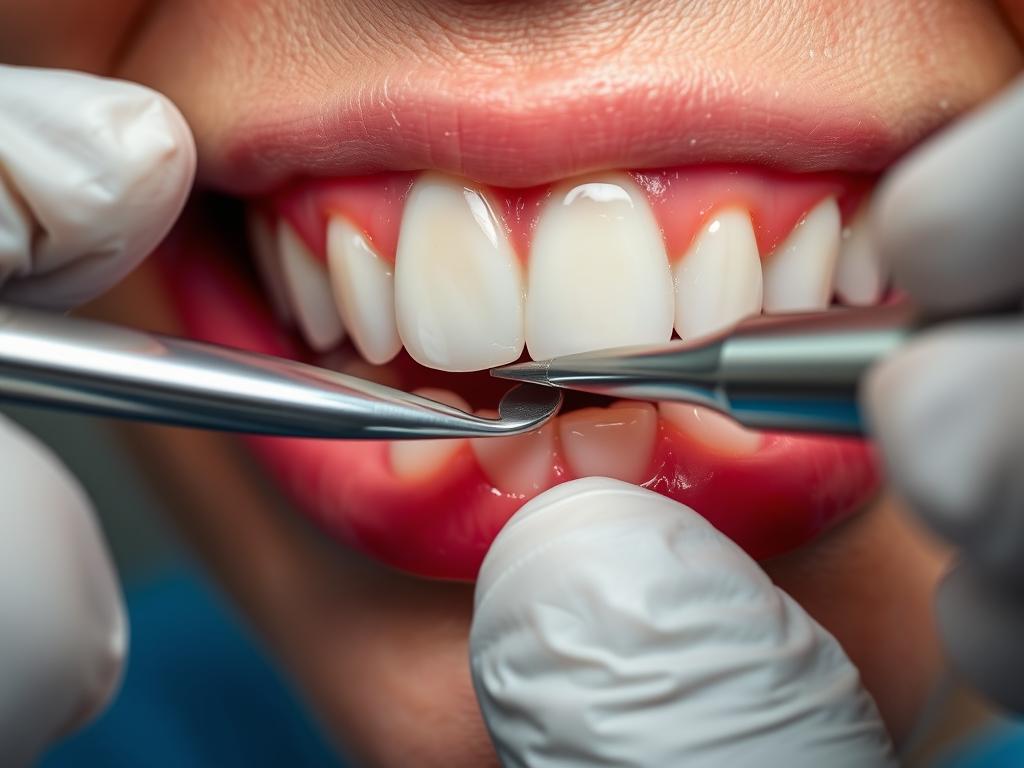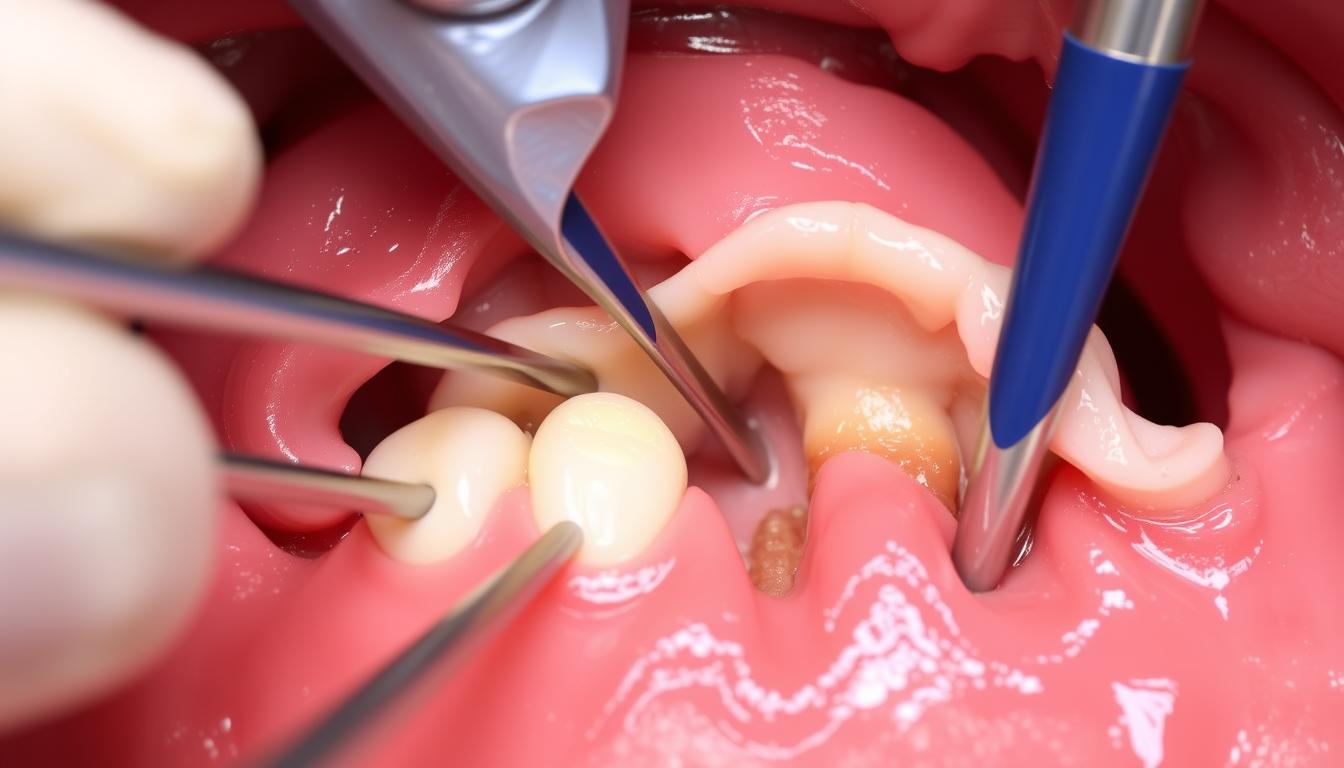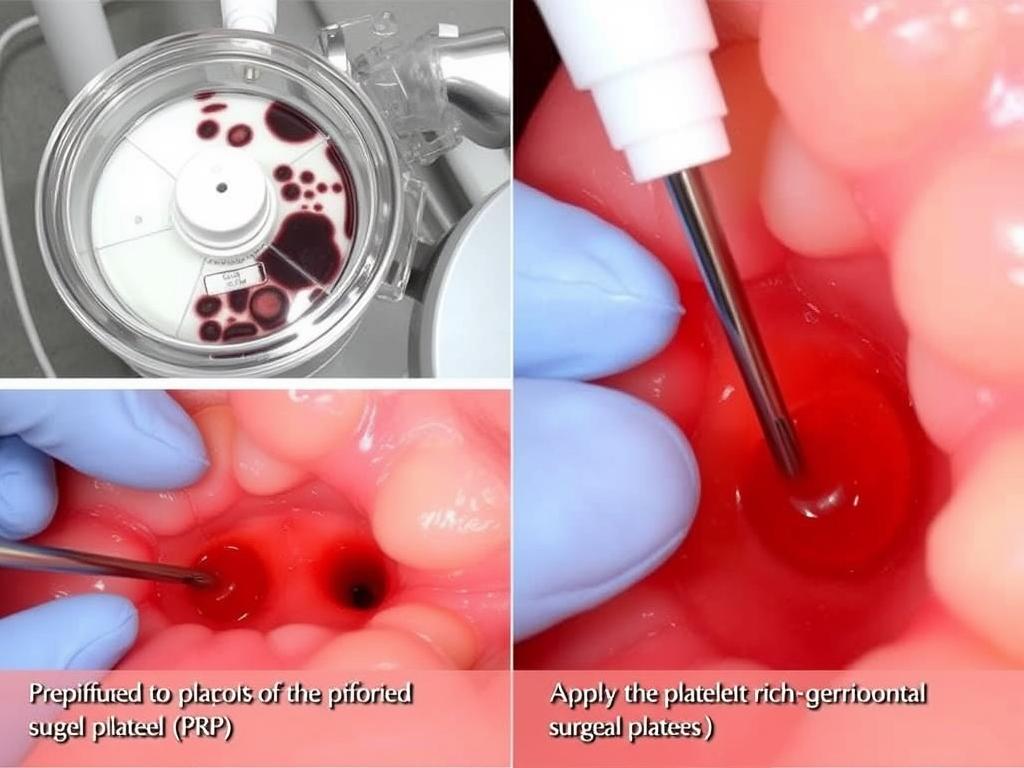Advanced periodontal disease represents a serious threat to your oral health, potentially leading to tooth loss and affecting your overall wellbeing. When gum disease progresses to its later stages, specialized treatment approaches become necessary to halt the infection, regenerate damaged tissues, and preserve your natural teeth. This comprehensive guide explores the full spectrum of advanced periodontal disease treatments available today, from non-surgical interventions to cutting-edge surgical techniques and emerging therapies.
The progression of periodontal disease from healthy gums to advanced periodontitis
Understanding Periodontal Disease Progression
Periodontal disease is a progressive bacterial infection that affects the gums and supporting structures of the teeth. It begins with gingivitis, characterized by red, swollen gums that may bleed during brushing or flossing. Without proper treatment, gingivitis can advance to periodontitis, where the infection damages the soft tissue and bone that support your teeth.
The Four Stages of Gum Disease
Stage 1: Gingivitis
The earliest stage of gum disease involves inflammation of the gums without bone loss. Symptoms include redness, swelling, and bleeding during brushing. At this stage, the condition is completely reversible with proper dental care.
Stage 2: Mild Periodontitis
As the infection progresses, bacteria penetrate beneath the gumline, affecting the supporting bone. Gums begin to pull away from teeth, creating pockets where bacteria thrive. Early bone loss (1-2mm) may occur.
Stage 3: Moderate Periodontitis
The infection continues to destroy gum tissue and bone, with pocket depths of 4-6mm. Teeth may become loose, and you might experience pain, bad breath, and gum recession. Bone loss typically ranges from 3-4mm.
Stage 4: Advanced Periodontitis
The final stage features extensive tissue and bone destruction (often exceeding 5mm). Teeth become severely loose and may shift position or fall out. Significant gum recession, persistent bad breath, and painful abscesses are common.
Advanced periodontal disease affects approximately 10-15% of adults worldwide, making it a leading cause of tooth loss in adults over 35.
American Academy of Periodontology
Diagnosis of Advanced Periodontal Disease
Before treatment can begin, a thorough diagnosis is essential. Periodontists use several methods to assess the severity of your condition:
Periodontal probing is essential for measuring pocket depths and assessing disease severity
Diagnostic Procedures
- Comprehensive oral examination
- Periodontal probing to measure pocket depths
- Assessment of gum recession and tooth mobility
- Dental X-rays to evaluate bone loss
- Microbial testing to identify specific bacteria
Signs That Indicate Advanced Stage Gum Disease
- Pocket depths greater than 5mm
- Significant gum recession
- Loose or shifting teeth
- Persistent bad breath
- Pus between teeth and gums
- Visible bone loss on X-rays
Non-Surgical Advanced Periodontal Disease Treatments
For many patients with advanced periodontal disease, treatment begins with non-surgical approaches aimed at controlling infection and inflammation. These conservative methods can be effective in managing the disease and may help avoid or reduce the need for surgical intervention.
Scaling and root planing is often the first line of treatment for advanced periodontal disease scaling & root-planing
Professional Deep Cleaning: Scaling and Root Planing
The cornerstone of non-surgical periodontal therapy is scaling and root planing, a deep cleaning procedure that removes bacterial plaque and tartar from both above and below the gumline. This procedure is typically performed under local anesthesia to ensure comfort.
The Scaling Process
During scaling, your dental professional uses specialized instruments to remove plaque and calculus (tartar) deposits from the tooth surface and from within the periodontal pockets. This eliminates the primary source of infection and inflammation.
Root Planing
Root planing involves smoothing the root surfaces of your teeth to remove bacterial toxins and create a clean surface that promotes healing and reattachment of the gum tissue to the teeth. This helps reduce pocket depths and inflammation.
Antibiotic Therapies
Antibiotics play a crucial role in controlling the bacterial infection associated with advanced periodontal disease. They can be administered in several ways:
Systemic Antibiotics
Oral antibiotics such as doxycycline, amoxicillin, or metronidazole may be prescribed to eliminate bacteria throughout the mouth. These are particularly useful for aggressive forms of periodontitis or when infection has spread beyond the gum tissue.
Local Antibiotic Delivery
Targeted antibiotic treatments can be applied directly to infected periodontal pockets. These include:
- Antibiotic fibers or threads placed in deep pockets
- Antibiotic gels injected into periodontal pockets
- Time-release antibiotic microspheres
- Antibiotic-containing chips placed in pockets after scaling
Take the First Step Toward Healthier Gums
Non-surgical treatments can be highly effective for managing advanced periodontal disease. Schedule a consultation with a periodontist to determine the best approach for your specific condition.Find a Periodontist Near You
Surgical Treatments for Advanced Periodontal Disease
When non-surgical treatments aren’t sufficient to manage advanced periodontal disease, surgical interventions become necessary. These procedures aim to reduce pocket depths, regenerate lost bone and tissue, and create an environment that’s easier to keep clean and healthy.
Periodontal flap surgery allows for thorough cleaning and treatment of affected roots and bone
Pocket Reduction Procedures
Flap Surgery (Osseous Surgery)
During this procedure, the gum tissue is temporarily folded back to expose the roots for more effective cleaning. The underlying bone may be reshaped to eliminate deformities caused by the disease. After cleaning, the gum tissue is secured back in place, often resulting in reduced pocket depths.
Benefits of Pocket Reduction
- Eliminates bacteria hiding in deep pockets
- Reduces inflammation and infection
- Makes home care more effective
- Halts progressive bone loss
- Improves overall gum health
Regenerative Procedures for Bone Loss in Gums
Bone grafting helps regenerate lost bone structure and support for teeth
Bone Grafting
When periodontal disease has destroyed the bone surrounding your teeth, bone grafts can help regenerate and rebuild this important structure. Grafting materials may include:
- Your own bone (autografts)
- Donated bone (allografts)
- Synthetic bone (alloplasts)
- Bovine-derived bone mineral
The graft serves as a scaffold for new bone growth, helping to stabilize teeth and prevent further tooth loss.
Guided Tissue Regeneration (GTR)
Often performed alongside bone grafting, guided tissue regeneration involves placing a special membrane between your gum tissue and the bone. This barrier prevents fast-growing gum tissue from entering the space where bone should regenerate, allowing slower-growing bone and connective tissue to fill in instead.
Tissue-Stimulating Proteins
Special gel-like materials containing tissue-stimulating proteins can be applied to a diseased tooth root. These proteins help your body regenerate bone and tissue that have been lost to periodontal disease.
Gum Recession Treatment
Gum grafting can effectively cover exposed roots and restore a healthy gumline
Advanced periodontal disease often leads to gum recession, where the gum tissue pulls away from the teeth, exposing the roots. This not only creates aesthetic concerns but also increases sensitivity and vulnerability to root decay. Gum grafting procedures can address these issues.
Types of Gum Grafts
- Connective tissue grafts: Tissue is taken from under a flap cut in the roof of your mouth and stitched to the gum tissue around the exposed root
- Free gingival grafts: Tissue is taken directly from the roof of your mouth and attached to the gum area
- Pedicle grafts: Tissue is grafted from gum around or near the tooth requiring repair
- Allograft material: Donor tissue can be used instead of taking tissue from your palate
Benefits of Gum Grafting
- Covers exposed tooth roots
- Reduces sensitivity
- Protects roots from decay
- Improves aesthetic appearance
- Stabilizes and prevents further gum recession
- Creates a more cleansable environment
Emerging Therapies for Advanced Periodontal Disease
The field of periodontics continues to evolve, with innovative treatments offering new hope for patients with advanced periodontal disease. These cutting-edge approaches often provide less invasive alternatives with reduced recovery times and improved outcomes.
Laser therapy offers a less invasive alternative for treating advanced periodontal disease
Laser-Assisted Periodontal Therapy
Laser technology has revolutionized the treatment of advanced periodontal disease. The most common laser procedure is Laser-Assisted New Attachment Procedure (LANAP), which uses a specialized dental laser to:
- Selectively remove diseased tissue without cutting healthy tissue
- Kill bacteria in periodontal pockets
- Stimulate stem cells in the tissues to form new attachment
- Seal the gum tissue against the tooth root
Benefits of laser therapy include minimal bleeding, reduced discomfort, faster healing, and less gum recession compared to traditional surgery. Many patients can return to their normal activities within 24 hours. Crown Lengthening: What It Is, Benefits, and Recovery Process
Biological Modifiers and Growth Factors
Platelet-rich plasma contains growth factors that accelerate tissue healing and regeneration
Platelet-Rich Plasma (PRP) and Platelet-Rich Fibrin (PRF)
These treatments use components from your own blood to accelerate healing and tissue regeneration. A small blood sample is taken and processed to concentrate platelets, which contain growth factors that stimulate tissue regeneration when applied to the surgical site.
Enamel Matrix Derivatives
Proteins derived from developing tooth enamel can be applied to diseased root surfaces to stimulate the cells that produce cementum, periodontal ligament, and bone. This helps recreate the tissues lost to periodontal disease.
Recombinant Human Growth Factors
Synthetic growth factors can be applied directly to periodontal defects to stimulate and enhance the body’s natural healing process. These include:
- Bone morphogenetic proteins (BMPs)
- Platelet-derived growth factor (PDGF)
- Fibroblast growth factor (FGF)
- Insulin-like growth factor (IGF)
Host Modulation Therapy
This approach focuses on modifying the host’s (patient’s) response to bacterial infection, rather than just targeting the bacteria themselves. Medications can help reduce the body’s inflammatory response, which is responsible for much of the tissue destruction in periodontal disease.
- Low-dose doxycycline: Used not for its antibiotic properties but for its ability to inhibit enzymes that break down gum tissue
- Non-steroidal anti-inflammatory drugs (NSAIDs): Can help reduce inflammation and slow bone loss
- Bisphosphonates: Medications that slow bone loss and may help in regeneration
Explore Advanced Treatment Options
Modern periodontal therapies offer new hope for even the most advanced cases of gum disease. Consult with a specialist to learn which innovative treatments might be right for your situation.Schedule a Periodontal Consultation
Aftercare and Long-Term Maintenance
Successful management of advanced periodontal disease doesn’t end with treatment. Long-term maintenance is crucial for preventing recurrence and preserving the results of therapy. A comprehensive aftercare program typically includes:
Regular professional maintenance is essential for long-term success after periodontal treatment
Professional Maintenance
- Frequent periodontal maintenance visits: Typically every 3-4 months
- Professional cleaning: Removes plaque and calculus from above and below the gumline
- Regular monitoring: Checks pocket depths, inflammation, and other signs of disease recurrence
- Periodic X-rays: Evaluates bone levels and monitors stability
Home Care Regimen
- Meticulous oral hygiene: Brushing at least twice daily with proper technique
- Interdental cleaning: Daily flossing and use of interdental brushes or water flossers
- Antimicrobial mouth rinses: May be recommended to control bacteria
- Special tools: Use of prescribed aids for cleaning around implants or complex restorations
Lifestyle Modifications
Certain lifestyle factors can significantly impact the success of periodontal treatment and the risk of disease recurrence:
Tobacco Cessation
Smoking and tobacco use are major risk factors for periodontal disease. Quitting smoking can dramatically improve treatment outcomes and reduce the risk of recurrence. Your dental professional can provide resources to help you quit.
Nutritional Support
A balanced diet rich in vitamins and minerals supports gum health and healing. Vitamin C, calcium, and vitamin D are particularly important for periodontal health. Consider nutritional counseling as part of your overall treatment plan.
Stress Management
Chronic stress can weaken your immune system and make it harder for your body to fight infection. Stress management techniques such as meditation, yoga, or counseling may help improve your periodontal health.
Management of Related Health Conditions
Conditions like diabetes, heart disease, and rheumatoid arthritis can affect periodontal health. Working with your physician to manage these conditions can improve your periodontal treatment outcomes.
The Importance of Compliance
Research shows that patients who strictly adhere to their maintenance program have a significantly lower risk of disease progression and tooth loss compared to those who don’t follow recommended care. Your commitment to aftercare is as important as the initial treatment itself.
Prevention Strategies for High-Risk Patients
Some individuals are at higher risk for developing or experiencing recurrence of advanced periodontal disease. If you fall into a high-risk category, additional preventive measures may be necessary.
Specialized oral hygiene tools can help high-risk patients maintain periodontal health
Identifying High-Risk Individuals
Several factors can place you at increased risk for advanced periodontal disease:
Genetic Factors
Research suggests that up to 30% of the population may be genetically susceptible to periodontal disease. If you have a family history of gum disease, you may need more aggressive preventive care.
Systemic Conditions
Certain health conditions significantly increase periodontal disease risk:
- Diabetes (particularly when poorly controlled)
- Cardiovascular disease
- Rheumatoid arthritis
- Osteoporosis
- Immune disorders
Lifestyle Factors
- Tobacco use (smoking or chewing)
- Excessive alcohol consumption
- Poor nutrition
- Chronic stress
Medication Effects
Some medications can affect gum health, including:
- Certain antihypertensives
- Immunosuppressants
- Anti-seizure medications
- Some calcium channel blockers
- Oral contraceptives
Enhanced Prevention Protocols
High-risk patients may benefit from additional preventive measures:
More Frequent Professional Care
- Periodontal maintenance every 2-3 months
- Regular comprehensive periodontal evaluations
- Annual or biannual full-mouth X-rays
Advanced Home Care
- Prescription-strength fluoride toothpaste
- Antimicrobial mouth rinses (chlorhexidine)
- Powered toothbrushes and water flossers
- Oral probiotics to promote healthy oral bacteria
Preventive Medications
- Low-dose doxycycline therapy
- Topical antibiotics
- Prescription antimicrobial rinses
Regular Screening and Monitoring
- Salivary diagnostic tests
- Genetic testing for periodontal susceptibility
- Bacterial DNA testing
- Inflammatory marker assessment
A personalized prevention plan is essential for high-risk patients
Frequently Asked Questions About Advanced Periodontal Disease
Is advanced periodontal disease curable?
Advanced periodontal disease isn’t technically “curable” in the traditional sense, but it is highly manageable with proper treatment. Once bone loss has occurred, it cannot be completely reversed to its original state. However, with appropriate treatment, the disease progression can be halted, and in many cases, some bone and tissue regeneration is possible.
The goal of advanced periodontal disease treatment is to control the infection, eliminate inflammation, prevent further damage, and restore as much function and aesthetics as possible. With proper professional care and diligent home maintenance, patients can maintain their teeth and oral health for many years after treatment. Scaling and Root Planing: Complete Guide to Deep Cleaning Treatment
What happens if periodontitis is left untreated?
Untreated advanced periodontitis leads to progressive destruction of the supporting structures around your teeth, including gum tissue, periodontal ligaments, and jawbone. This results in:
- Increasing tooth mobility and eventual tooth loss
- Recurrent periodontal abscesses and infections
- Persistent bad breath and unpleasant taste
- Difficulty chewing and speaking
- Changes in bite and facial structure as teeth shift
Beyond oral health, untreated periodontal disease has been linked to several systemic conditions, including heart disease, diabetes complications, respiratory infections, and adverse pregnancy outcomes. The chronic inflammation and bacterial burden can impact your overall health and quality of life.
Can severe gum disease be reversed?
The term “reversed” must be understood carefully in the context of severe gum disease. While early gingivitis can be completely reversed, advanced periodontal disease involves permanent changes to bone and tissue structure that cannot be fully reversed to their original state.
However, with comprehensive treatment, significant improvements are possible:
- The disease process can be stopped
- Inflammation can be eliminated
- Pocket depths can be reduced
- Some bone and tissue can be regenerated through advanced procedures
- Tooth stability can be improved
- Further progression can be prevented
The extent of improvement depends on the severity of the disease, your overall health, compliance with treatment recommendations, and individual healing capacity. Early intervention always yields better results.
How long does periodontal treatment take?
The timeline for advanced periodontal disease treatment varies based on the severity of your condition and the specific procedures needed. A typical treatment sequence might include:
- Initial phase (1-2 months): Scaling and root planing, often performed in multiple sessions
- Healing and evaluation (4-6 weeks): Allowing tissue to heal and assessing response to initial therapy
- Surgical phase (if needed): One or more surgical procedures, with healing time between each
- Post-surgical healing (1-3 months per procedure): Recovery and tissue regeneration
- Restorative phase (varies): Any needed dental restorations after periodontal health is stabilized
From start to finish, comprehensive treatment of advanced periodontal disease typically takes 6-12 months, followed by ongoing maintenance care indefinitely. Your periodontist will provide a more specific timeline based on your individual treatment plan.
Is periodontal treatment painful?
Modern periodontal treatments utilize effective anesthetics and pain management techniques to ensure your comfort during procedures. Most patients report minimal discomfort during treatment.
For non-surgical procedures like scaling and root planing, local anesthesia is typically used to numb the treatment area. For surgical procedures, you may be offered additional options such as sedation dentistry to help you relax.
After treatment, some soreness, sensitivity, and mild swelling are normal but usually manageable with over-the-counter pain medications. Your dental professional will provide specific post-treatment instructions and pain management recommendations for your recovery period.
Taking Action Against Advanced Periodontal Disease
Advanced periodontal disease represents a serious threat to your oral health and overall wellbeing, but with modern treatment approaches, even severe cases can be effectively managed. The key is to seek professional care promptly and commit to the recommended treatment and maintenance program.
Remember that successful management of advanced periodontal disease requires a partnership between you and your dental professionals. Your periodontist provides the expertise and treatments, but your daily home care and compliance with maintenance recommendations are equally crucial for long-term success.
With proper treatment and maintenance, patients can maintain a healthy smile for years to come
Don’t Wait to Address Advanced Periodontal Disease
Early intervention offers the best chance for successful treatment outcomes. Contact a periodontal specialist today to schedule a comprehensive evaluation and discuss your treatment options.Schedule Your Periodontal Consultation













5sfsfm
jj5cfu
lqpgph